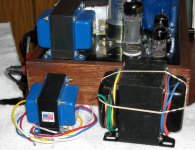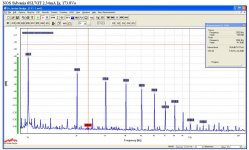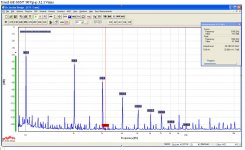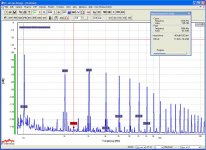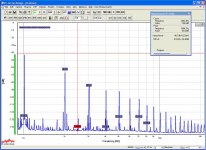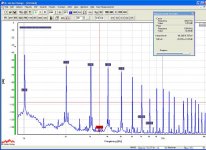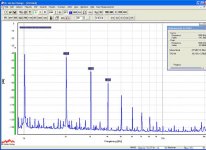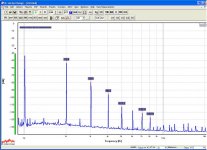I’m starting the design of a 6A3/6B4G/6C4C SE Amplifier. This will be a capacitive coupled amp, without global feedback.
I’ve started at the output and am working backwards through the design as this makes more sense to me.
The output will be 8 Ohms as all of my speakers are 8 Ohm. My first choice was to have Edcor make a 10W version of the CXSE series with 3K to 8R, however they informed me that they were not set up to do a 10W CXSE format transformer.
So, transformer selection came down to (1) Edcor CXSE25-8-2.5K (or 3K, 3.2K, 3.75K), (2) Edcor GXSE10-8-2.5K, (3) One Electron UBT-3 15W 3K:16R, (4) Transcendar 10W 3K:8R. James, Tango, and others having been ruled as they are out of my budget range.
The Edcor GXSE is thrown in as I have a set already and want to compare them to higher quality transformers.
Final selection was the UBT-3. Edcor was ruled out due to size. I just can’t see dropping 20# worth of output transformers on a 3W per channel amp. After receiving the UBT-3s, I’m glad I did not get the Edcor transformers as they would have been gross overkill.
The Transcendar looks equally as good as the UBT-3, however the 16 Ohm tap on the UBT-3 may allow for trying cathode feedback.
As a note, the James, Tango and other high end transformers recommended for 2A3 are all in the same weight range as the UBT-3 and Transcendar.
The biasing will be cathode biased at -45V with DC on the filaments using DC filament regulators.
Here is a comparison of the UBT-3, 10W and 15W Edcor transformers.
I’ve started at the output and am working backwards through the design as this makes more sense to me.
The output will be 8 Ohms as all of my speakers are 8 Ohm. My first choice was to have Edcor make a 10W version of the CXSE series with 3K to 8R, however they informed me that they were not set up to do a 10W CXSE format transformer.
So, transformer selection came down to (1) Edcor CXSE25-8-2.5K (or 3K, 3.2K, 3.75K), (2) Edcor GXSE10-8-2.5K, (3) One Electron UBT-3 15W 3K:16R, (4) Transcendar 10W 3K:8R. James, Tango, and others having been ruled as they are out of my budget range.
The Edcor GXSE is thrown in as I have a set already and want to compare them to higher quality transformers.
Final selection was the UBT-3. Edcor was ruled out due to size. I just can’t see dropping 20# worth of output transformers on a 3W per channel amp. After receiving the UBT-3s, I’m glad I did not get the Edcor transformers as they would have been gross overkill.
The Transcendar looks equally as good as the UBT-3, however the 16 Ohm tap on the UBT-3 may allow for trying cathode feedback.
As a note, the James, Tango and other high end transformers recommended for 2A3 are all in the same weight range as the UBT-3 and Transcendar.
The biasing will be cathode biased at -45V with DC on the filaments using DC filament regulators.
Here is a comparison of the UBT-3, 10W and 15W Edcor transformers.
Attachments
6A3 Driver Requirements:
I missed this thread until today.
http://www.diyaudio.com/forums/tubes-valves/227113-gm70-driver-tube-tests.html
Rather serendipitous since I am pondering what to drive the 6A3 with.
Drive requirements are 90Vp-p, or roughly 32Vrms. The minimum input gain requirement to be driven from a 1.5Vrms source as 21.3v/v.
Mu greater than 21.3 is required to get a gain of 21.3 unless a Current Source load is used (SS?), and a gain greater than minimum would allow for cathode degeneration but this is not specifically required.
My preference is to use an Octal Base tube for aesthetic reasons as I think all Octal looks better than mixed.
The 6SL7 with it’s mu of 70 is a possibility, however it’s low Ia is a concern for potential slew rate limiting unless both halves are in parallel. I’ve seen several designs using it with acceptable results.
The 6SN7 is a good choice for low distortion and moderate drive, however the Mu of 20 is problematic as it is below that necessary to fully drive the 6A3 with 1.5V in.
Calculate slew rate requirements before proceeding, using 20KHz bw.
For the output tube we have:
Cga = 16.5pf
Mu = 4.2
Cmiller = 16.5*4.2 = 69.3
Cgk =7.5pf
Cstray=10pf
Ctotal ~= 82pF
Sr=2*PI*F*Vpk = 2 * 3.1415*20KHz*45 = 5.654V/us
Charging current requirement is thus 82pF*324V/us = 0.464mA
Using a rule of 5 this implies a need for 2.5mA minimum Ia for a tube to drive the capacitance with low distortion. This supports my suspicion that the 6SL7 may well be slew rate limited unless it is used with parallel sections and possibly higher than specified bias current.
Looking outside the traditional tubes, etc, I started digging through my box of loose tubes.
I ran across several 6G6Gs that the datasheet shows triode strapped data for. Linearity looks good, however Mu of only 9.5 pretty much rules them out. 6SJ7 looks better at Mu=19, and the triode strapped curves look good. I’ll test these for distortion before making a decision.
6SH7 is right out due to the note about Hum. Likewise the 6S7 with low Gm and high RP is probably out (no Triode strapped curves).
Odd triode (mostly with diodes) combinations include the 6SQ7, 6AQ7, and 6Q7.
6AQ7 is very interesting as its curves look very similar to 6SL7 curves. It comes in a single triode with two diodes and is reasonably priced. It is specified for 2.3ma at 250V so dissipation should be ok at the required 2.64mA at a lower Va that I will operate at.
6Q7 looks pretty linear, and again I only have them in the metal MT8-A, but there are glass versions.
This brings me to the TwinTriodes (Common Cathode) such as the 6SC7, 6N7 etc.
The 6SC7 looks promising as curves are given both in ma and sub-ma and it is recommended as a resistance-coupled amplifier. Paralleling the sections allows for halving the RP size and improves drive allowing for 4mA total. The downside is that all of these that I have are in the butt-ugly metal can MT8-G1 that would give a very industrial appearance to the amp. It looks like other manufacturers made it in a GT version, which would look better. It’s curves are very similar to the 6SL7.
6N7 is similar but with a lower Mu (35) as it is a power output device.
I’m still digging around to see if I can find any more tubes to investigate. 7 and 9 pin tubes aren’t completely ruled out, but I will hold off looking at them until I finish looking at Octals.
I tested several 6SN7s and 6SL7s to see how they looked at 90Vp-p out. Interestingly enough, the 6SL7 has lower distortion (unloaded) than the 6SN7, but it's harmonics die out slower than the 6SN7s harmonics. By the 4th harmonic, the 6SN7s were lower and stayed so.
I tested several of each type tube from different manufacturers and they were consistent in this regard.
I missed this thread until today.
http://www.diyaudio.com/forums/tubes-valves/227113-gm70-driver-tube-tests.html
Rather serendipitous since I am pondering what to drive the 6A3 with.
Drive requirements are 90Vp-p, or roughly 32Vrms. The minimum input gain requirement to be driven from a 1.5Vrms source as 21.3v/v.
Mu greater than 21.3 is required to get a gain of 21.3 unless a Current Source load is used (SS?), and a gain greater than minimum would allow for cathode degeneration but this is not specifically required.
My preference is to use an Octal Base tube for aesthetic reasons as I think all Octal looks better than mixed.
The 6SL7 with it’s mu of 70 is a possibility, however it’s low Ia is a concern for potential slew rate limiting unless both halves are in parallel. I’ve seen several designs using it with acceptable results.
The 6SN7 is a good choice for low distortion and moderate drive, however the Mu of 20 is problematic as it is below that necessary to fully drive the 6A3 with 1.5V in.
Calculate slew rate requirements before proceeding, using 20KHz bw.
For the output tube we have:
Cga = 16.5pf
Mu = 4.2
Cmiller = 16.5*4.2 = 69.3
Cgk =7.5pf
Cstray=10pf
Ctotal ~= 82pF
Sr=2*PI*F*Vpk = 2 * 3.1415*20KHz*45 = 5.654V/us
Charging current requirement is thus 82pF*324V/us = 0.464mA
Using a rule of 5 this implies a need for 2.5mA minimum Ia for a tube to drive the capacitance with low distortion. This supports my suspicion that the 6SL7 may well be slew rate limited unless it is used with parallel sections and possibly higher than specified bias current.
Looking outside the traditional tubes, etc, I started digging through my box of loose tubes.
I ran across several 6G6Gs that the datasheet shows triode strapped data for. Linearity looks good, however Mu of only 9.5 pretty much rules them out. 6SJ7 looks better at Mu=19, and the triode strapped curves look good. I’ll test these for distortion before making a decision.
6SH7 is right out due to the note about Hum. Likewise the 6S7 with low Gm and high RP is probably out (no Triode strapped curves).
Odd triode (mostly with diodes) combinations include the 6SQ7, 6AQ7, and 6Q7.
6AQ7 is very interesting as its curves look very similar to 6SL7 curves. It comes in a single triode with two diodes and is reasonably priced. It is specified for 2.3ma at 250V so dissipation should be ok at the required 2.64mA at a lower Va that I will operate at.
6Q7 looks pretty linear, and again I only have them in the metal MT8-A, but there are glass versions.
This brings me to the TwinTriodes (Common Cathode) such as the 6SC7, 6N7 etc.
The 6SC7 looks promising as curves are given both in ma and sub-ma and it is recommended as a resistance-coupled amplifier. Paralleling the sections allows for halving the RP size and improves drive allowing for 4mA total. The downside is that all of these that I have are in the butt-ugly metal can MT8-G1 that would give a very industrial appearance to the amp. It looks like other manufacturers made it in a GT version, which would look better. It’s curves are very similar to the 6SL7.
6N7 is similar but with a lower Mu (35) as it is a power output device.
I’m still digging around to see if I can find any more tubes to investigate. 7 and 9 pin tubes aren’t completely ruled out, but I will hold off looking at them until I finish looking at Octals.
I tested several 6SN7s and 6SL7s to see how they looked at 90Vp-p out. Interestingly enough, the 6SL7 has lower distortion (unloaded) than the 6SN7, but it's harmonics die out slower than the 6SN7s harmonics. By the 4th harmonic, the 6SN7s were lower and stayed so.
I tested several of each type tube from different manufacturers and they were consistent in this regard.
Attachments
The 6SL7 with it’s mu of 70 is a possibility, however it’s low Ia is a concern for potential slew rate limiting unless both halves are in parallel. I’ve seen several designs using it with acceptable results.
The 6SN7 is a good choice for low distortion and moderate drive, however the Mu of 20 is problematic as it is below that necessary to fully drive the 6A3 with 1.5V in.
Do you try on 6SL7 in SRPP and 6SN7 in 2 stage of amplifying ?
one triode of 6SL7 can run 150Vak 1.5mA with good result.
Just use a 300B design with 6A3/6B4G tubes, bias at -60V, B+ at 350V. Drive with cascoded 6SN7's for a romantic sound or a single D3a for a modern quick transparent sound.
I've done this with NOS RCA 2A3's and it sounds amazing. Forget the datasheets, those ratings are far too conservative. These tubes are capable of far more power.
I've done this with NOS RCA 2A3's and it sounds amazing. Forget the datasheets, those ratings are far too conservative. These tubes are capable of far more power.
Last edited:
So far I have not assembled the amp.
I'm trying to limit the design to two stages total.
I'm testing potential driver tubes in a lab configuration with adjustable cathode resistor (fully bypassed) and Gyrator anode load. This is buffered by a FET source follower, which runs into a step attenuator (0, -20dB, -40dB) and then a Twin T filter and differential buffer to drive my sound card.
Right now I'm sorting through potential driver tubes.
I'm trying to limit the design to two stages total.
I'm testing potential driver tubes in a lab configuration with adjustable cathode resistor (fully bypassed) and Gyrator anode load. This is buffered by a FET source follower, which runs into a step attenuator (0, -20dB, -40dB) and then a Twin T filter and differential buffer to drive my sound card.
Right now I'm sorting through potential driver tubes.
With 2 stages, if your source only outputs 2Vrms like most sources do, then your choice of driver tube is very limited. You needs lots of gain, with relatively low Rp.
In real world, for music, mu=40 is enough. But for television and movies, watching youtube, etc... it's not enough. You want at least mu=70. CCS and FET follower helps, but still... your choice is very limited.
In real world, for music, mu=40 is enough. But for television and movies, watching youtube, etc... it's not enough. You want at least mu=70. CCS and FET follower helps, but still... your choice is very limited.
Last edited:
This amp will only be used for music. No TV, movies or youtube. It will eventually be my shop sound system, but I want to use it in the den for a while to evaluate it. Sources will be CD, Cassette, and vinyl.
For filaments, I have both Coleman regulators and Tom's universal filament regulator to experiment with. The two output tubes will run independent filament transformer windings.
For filaments, I have both Coleman regulators and Tom's universal filament regulator to experiment with. The two output tubes will run independent filament transformer windings.
Hi!
I have used the 6N7 a lot as driver tube in two stage amps. Works nicely
Thomas
Does anyone use 6F8G for driver tube ? These tube have the same data to 6N7, 6SN7, 6J5, 6P5 ...
Hi
6N7 and 6SN7 do not have the same data! They are quite different
Thomas
These tube have the same data to 6N7, 6SN7, 6J5, 6P5 ...
6N7 and 6SN7 do not have the same data! They are quite different
Thomas
Hi!
A nice tube which is electrically equivalent to the 6N7 is the 6A6:
VinylSavor: Tube of the Month: The 6A6
Best regards
Thomas
A nice tube which is electrically equivalent to the 6N7 is the 6A6:
VinylSavor: Tube of the Month: The 6A6
Best regards
Thomas
I tried 6AC7s last night out of a dozen used tubes, two looked like new and came in around 0.1%thd at 102Vp-p. Nice decay in harmonics below -100dB by the 4th. Most of the tubes came in between 0.15 and 0.24%thd, with a couple worse than 0.3% and nasty harmonics slowly decaying.
I think I have a half dozen 6N7s so I'll give them a try next. A couple are in boxes, but may not be NOS as they came from a TV repair shop that put used tubes back in boxes and forgot to throw them out.
I think I have a half dozen 6N7s so I'll give them a try next. A couple are in boxes, but may not be NOS as they came from a TV repair shop that put used tubes back in boxes and forgot to throw them out.
Only two 6N7s, and a 7 6J5 plus two 6J5-GTs.
The 6N7s were great at low current but above 6mA they went wonkie. High order harmonics rapidly increased.
6Y7 was a disappointment as distortion went up rapidly above 3mA. Not much drive there even with the plates in parallel.
6J5GT looked promising although a bit high on second harmonic.
Plots are:
6N7 at 6.5mA
6N7 at 6mA
6N7 at 7mA
6Y7 at 2mA
6J5GT at 5mA
The 6N7s were great at low current but above 6mA they went wonkie. High order harmonics rapidly increased.
6Y7 was a disappointment as distortion went up rapidly above 3mA. Not much drive there even with the plates in parallel.
6J5GT looked promising although a bit high on second harmonic.
Plots are:
6N7 at 6.5mA
6N7 at 6mA
6N7 at 7mA
6Y7 at 2mA
6J5GT at 5mA
Attachments
Hi!
Judging the distortion results by the current alone is meaningless. What was the test circuit and other op point parameters? Could well be that the 6N7 was driven into grid current at the higher current op points. Then higher distortion is expected. If other parameters get adjusted the results might well be different.
Best regards
Thomas
Judging the distortion results by the current alone is meaningless. What was the test circuit and other op point parameters? Could well be that the 6N7 was driven into grid current at the higher current op points. Then higher distortion is expected. If other parameters get adjusted the results might well be different.
Best regards
Thomas
Good point. I did verify that they weren't approaching clipping by increasing the output to 120Vp-p while watching the waveform.
All were at Va ~= 200V.
I just re-measured one 6N7 and got this:
Vgk = 2.77V
Ik = 7.48mA
Va = 199.8
Vi = 2.82Vp-p
Vo = 103Vp-p
Clipping occurs on the positive peak first just above 148Vp-p
All were at Va ~= 200V.
I just re-measured one 6N7 and got this:
Vgk = 2.77V
Ik = 7.48mA
Va = 199.8
Vi = 2.82Vp-p
Vo = 103Vp-p
Clipping occurs on the positive peak first just above 148Vp-p
- Status
- This old topic is closed. If you want to reopen this topic, contact a moderator using the "Report Post" button.
- Home
- Amplifiers
- Tubes / Valves
- 6A3 / 6B4G Design
